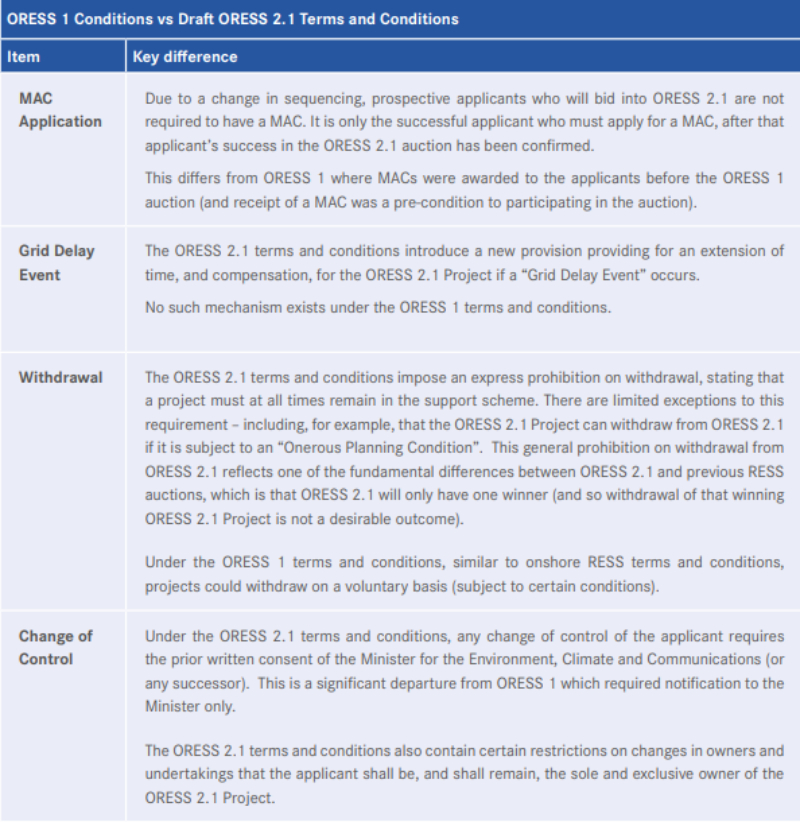- within Compliance, Media, Telecoms, IT, Entertainment and Strategy topic(s)
Background
Ireland has ambitious offshore renewable energy targets – aiming to deliver 5 GW of offshore wind by 2030, at least 20 GW by 2040 and 37 GW by 2050.
The Department of the Environment, Climate and Communications ("DECC"), coordinated through the Offshore Wind Delivery Taskforce ("OWDT"), recently announced a suite of policy initiatives intended to support these ambitious targets. These include:
- The Future Framework Policy Statement for Offshore Renewable Energy ("Future Framework");
- The Draft Offshore Renewable Electricity Support Scheme 2.1 ("ORESS 2.1") Terms & Conditions; and
- The Draft South Coast Designated Maritime Area Plan ("Draft SC-DMAP").
We have set out below an overview of these key policy developments.
Future Framework
On 1 May 2024, the Future Framework was published. It sets out DECC's long-term (post-2030) ambitions to realise Ireland's offshore renewable energy targets, laying down a roadmap for how these targets will be achieved.
The state-led development of the Future Framework means that DECC, in consultation with other government departments and agencies such as the Maritime Area Regulatory Authority ("MARA"), the National Parks and Wildlife Service and the Department of Agriculture, Food and the Marine, will decide on the location of offshore renewable energy generation development sites (under the relatively new regulatory regime introduced in the Maritime Area Planning Act ("MAP Act")).
The Future Framework sets out 29 key actions including the following seven priority actions to develop Ireland's long-term, plan-led, approach to offshore renewable energy:
1 Providing the structures and supports necessary to establish a future Designated Maritime Area 1 Plan ("DMAP") roadmap
DMAPs, as further discussed below, will determine the marine areas where all future offshore renewable energy projects can be developed and coordinated.
2 Exploring the feasibility of implementing a competitive Maritime Area Consent ("MAC") framework
MARA will explore the potential to develop a competitive MAC process, taking into account experience from other jurisdictions who have put in place similar processes.
3 Exploring the possibility of a roadmap for future offshore renewable energy development
In Q1 2025, DECC will explore the possibility of developing a more detailed roadmap for future offshore renewable energy development, including the potential for interim offshore renewable capacity targets and sub-targets for innovative technologies.
4 Designing and developing a successor support scheme to ORESS
The ORESS scheme expires at the end of 2025. A successor scheme is therefore required and, in order to avoid market disruption, will need to be designed, state aid approved and in operation by 2026.
5 Maximising capacity from alternative routes to market
DECC recognises alternative routes to market emerging in other offshore markets (ie, projects financed by merchant means or via corporate power purchase agreements) as well as new project types (ie, power-to-X, multipurpose interconnectors and non-grid limited projects). DECC is taking action to identify and assess the enabling supports required to maximise capacity from such alternative routes to market.
6 Aligning infrastructure efficiencies to consider generation, grid and route to market
DECC is seeking to align infrastructure efficiencies in a manner which considers offshore generation, grid and routes to market to ensure offshore renewable energy targets are coordinated with existing, planned and / or prospective infrastructure development. For example, through the implementation of EirGrid's Grid Implementation Plan.
7 Assessing the potential to deploy floating offshore wind at scale in Irish waters
In order to identify floating offshore wind opportunities, DECC proposes to conduct a study to assess the potential to deploy floating offshore wind in Irish waters, analysing capacity at key strategic locations (taking account of, and learning from, the upcoming global auctions dedicated to floating wind).
ORESS 2.1
On 3 May 2024, DECC published the draft terms and conditions for ORESS 2.1 for a circa 900 MW site off the South Coast of Ireland, known as Tonn Nua (the "ORESS 2.1 Project"). On 3 May 2024, DECC published the draft terms and conditions for ORESS 2.1 for a circa 900 MW site off the South Coast of Ireland, known as Tonn Nua (the "ORESS 2.1 Project").
Whilst the final terms and conditions remain to be confirmed (and will follow in due course), we have summarised some of the key differences against the ORESS 1 terms and conditions below:

The consultation on the ORESS 2.1 terms and conditions closed on 7 June 2024 and the final terms and conditions are due to be announced later this year.
To read the full article click here
The content of this article is intended to provide a general guide to the subject matter. Specialist advice should be sought about your specific circumstances.








